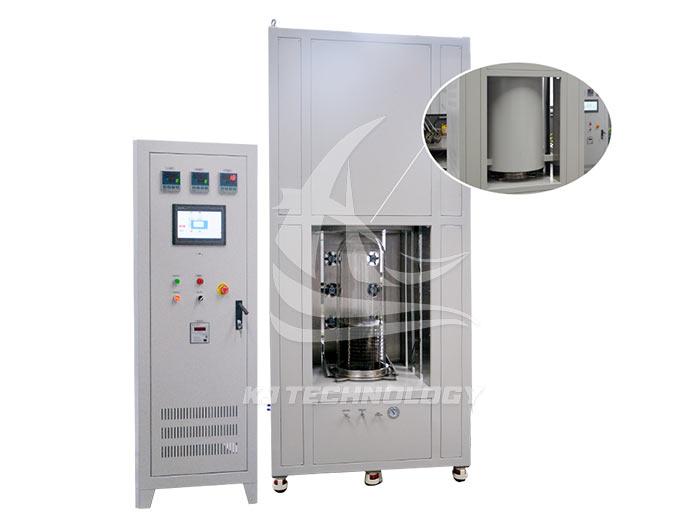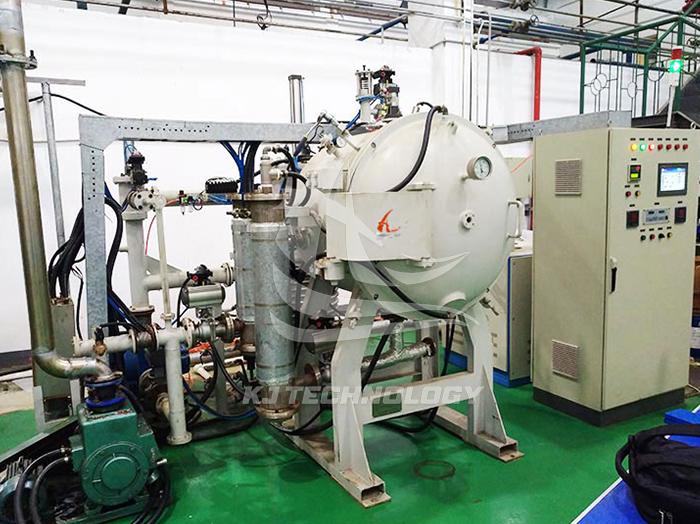Precautions for using gas vacuum furnace
 07-29-2025 Author: KJ technology
07-29-2025 Author: KJ technology
Gas vacuum furnace, as a precision heat treatment equipment, is widely used in fields such as battery manufacturing, ceramic processing, and metal material processing. To ensure the safe operation of equipment, extend its service life, and ensure process quality, the following key points should be noted during use:
1. Preparation before operation
Equipment inspection
Check if key components such as vacuum pump, heating element, temperature sensor, pressure gauge, etc. are working properly.
Confirm the sealing of the furnace body and check whether there are leaks or damages in the flanges, observation windows, valves, and other parts.
Check if the pipeline connections of the gas supply system (such as nitrogen, argon, oxygen, etc.) are secure and if the pressure is stable.
Environmental requirements
Ensure that there are no flammable or explosive materials around the equipment, good ventilation, and avoid high temperature or humid environments.
The operating table should be flat to avoid the impact of vibration on the equipment.
Confirmation of process parameters
Set temperature, vacuum degree, insulation time, gas flow rate and other parameters according to process requirements to avoid overheating or overpressure operation.
For new processes or materials, small-scale experiments should be conducted first to verify the rationality of parameters before large-scale production.
2. Precautions during operation
Vacuum system operation
Vacuum pumping sequence: First start the mechanical pump to pre pump to low vacuum, then switch to the molecular pump or diffusion pump to pump high vacuum, to avoid direct high vacuum pumping causing damage to the pump body.
Vacuum monitoring: Real time observation of vacuum gauge readings. If the vacuum drops too quickly or cannot reach the set value, the machine should be stopped immediately to check for leaks.
Vacuum breaking operation: It is necessary to slowly introduce dry nitrogen or argon gas to avoid rapid inflation that may cause sudden pressure changes in the furnace and damage the workpiece or equipment.
Heating and cooling control
Heating rate: Control the heating rate according to the material characteristics to avoid cracking or deformation of the workpiece caused by thermal stress. For example, ceramic materials need to be slowly heated to the sintering temperature.
Insulation stage: Ensure temperature uniformity and avoid local overheating or underheating. It can be monitored through thermocouple multi-point temperature measurement or infrared thermometer.
Cooling method: Choose natural cooling, air cooling, or oil cooling according to process requirements. During gas cooling, it is necessary to control the gas flow rate to avoid cracks in the workpiece caused by rapid cooling.
Gas protection and reaction
Inert gas protection: When processing easily oxidizable materials such as lithium and magnesium alloys at high temperatures, high-purity nitrogen or argon gas should be continuously introduced to prevent oxidation.
Reaction gas control: If it is necessary to introduce reaction gases such as oxygen and hydrogen, the flow rate and proportion must be strictly controlled to avoid the risk of explosion. For example, in the oxidation treatment of carbon materials, precise control of oxygen partial pressure is required.
Loading and fixing of workpieces
Workpiece placement: Avoid overlapping or contacting the furnace wall to ensure uniform heat conduction. For easily deformed workpieces, specialized fixtures need to be used for fixation.
Loading capacity: Control the number of workpieces in the furnace to avoid uneven temperature field or decreased vacuum caused by excessive loading.
3. Safety protection measures
Personal Protection
Operators need to wear protective goggles, insulated gloves, dust masks, etc. to avoid high temperatures, splashes, or harmful gas injuries.
When handling toxic or corrosive materials, it is necessary to operate in a fume hood and be equipped with emergency eyewash and shower equipment.
Equipment safety
Install protection devices for overheating, overpressure, and leakage, and regularly test their sensitivity.
Do not start heating when the furnace door is not fully closed to avoid radiation damage.
The emergency stop button should be placed in a prominent position to ensure that operators can quickly respond to unexpected situations.
Fire and explosion prevention
It is strictly prohibited to handle flammable and explosive materials such as organic solvents, metal powders, etc. inside the furnace.
Regularly clean the residue inside the furnace to prevent carbon deposition from causing fires.
Equip fire extinguishers or carbon dioxide fire extinguishing systems and regularly check their expiration dates.
4. Maintenance and upkeep
Daily cleaning
Clean the residue and oxides inside the furnace after each use to avoid contaminating subsequent workpieces.
Regularly wipe the surface of the furnace body to keep the equipment clean.
Regular maintenance
Vacuum system: Check the oil level and quality of the vacuum pump every 3-6 months, and replace it if necessary; Clean or replace the vacuum valve and sealing ring.
Heating element: Check the heating wire or graphite heating element annually for aging or breakage, and replace it in a timely manner.
Temperature sensor: Regularly calibrate thermocouples or infrared thermometers to ensure temperature measurement accuracy.
Lubrication and anti-corrosion
Regularly apply high-temperature resistant grease to moving parts such as furnace door hinges and vacuum pump rotors.
When not in use for a long time, it is necessary to fill the furnace with dry nitrogen gas for protection to avoid corrosion of metal components in humid environments.
5. Exception handling
Insufficient vacuum degree
Check whether the vacuum pump is working properly, whether the pipeline is leaking, and whether the furnace door seal is good.
If the leakage point is difficult to locate, a helium mass spectrometer leak detector can be used for precise detection.
Abnormal temperature
High temperature: Check if the heating element is short circuited or if the PID parameter settings are reasonable.
Low temperature: Confirm if the heating power is sufficient and if the thermocouple is in good contact.
Gas supply failure
If the gas flow rate is unstable, check the gas source pressure, pipeline blockage, or solenoid valve failure.
In emergency situations, the gas valve should be immediately closed to prevent backflow or leakage.








